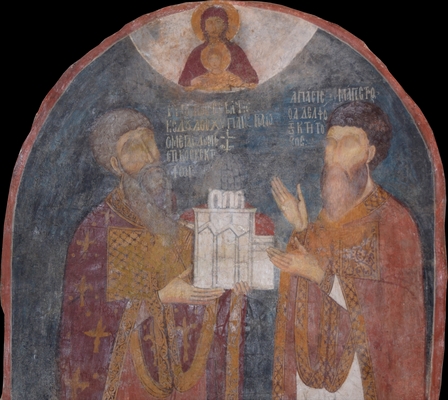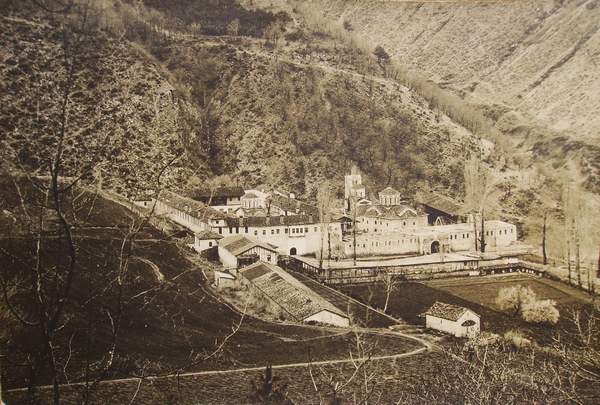History

Images if the founders of the monastery Grigorii And Abasii Bakuriani from the Ossuary church, XIVc.
Bachkovo Monastery ‘Assumption of the Holy Virgin’ was established by the great Domestic of the West Grigorii Bakuriani under the reign of the Byzantine Emperor Alexis I Komnin. Bakuriani was a friend of the emperor and the ruler of the geographical region, in which the monastery was built. His brother, Abasii, also a co-founder, provided significant financial support but unfortunately did not survive until the construction was finished.
In the monastery by-laws(Tipikon), Grigorii clearly states his motives behind the establishment of the holy place:
“Since it is profitable and the duty of every faithful orthodox Christian who has been baptized…always to expect the end to take thought for the day of his death, to expect the resurrection of everyone and himself from the dead, and to meditate on that fearful and awful examination in the just judgment of Christ…according to that holy voice in the gospel concerning that [threat], and hence each one “to give” to God “the ransom”…for all these reasons, I the often-mentioned sebastos Gregory, and megas domestikos, the very sinful and unworthy servant of Christ…I desired this from the beginning…and until now I longed to build a very beautiful church and round it a dwelling for monks and in it a burial place for the repose of my sinful bones,…
So now since God has deemed me worthy to accomplish the longing of my heart, the holy churches have been completed with the fortified monastery round them and the cells…For I dare to say that it was not completed with any other money belonging to someone else or as a result of any wrongdoing or even with forced labor, and exceedingly abusive impositions on my dependent peasants,… but from my own rights and personal labors and zealous efforts.”
The monks were to be 50 in number with one abbot in charge. This was a significant number as only two other institutions in Byzantium had more. The monastery’s first abbot was Grigorii Vanski. The first monks came from the eastern regions of Byzantium - Tao, Klardz and Iveria. They were either of Georgian or Armenian origin like the founders.
The founders Grigorii and Abasii orphaned at an early age and managed to succeed in life though faithful service to Byzantine Emperors, perseverance and discipline.
According to the 24th Chapter of the monastery By-laws, no disciples of Greek origin were to be allowed into it, those were meant to be primarily Georgian.
Grigorii managed to obtain a special royal decree which gave the monastery complete independence from any other Orthodox establishment, especially from the metropolitan bishop of Plovdiv and also from paying taxes. The decree was signed by the Jerusalem patriarch Evtimii. Grigorii signed over to the monastery various properties around the area – in Asenovgrad, Rhodope Mountains, and Aegean Trace (around Komotini and Thessaloniky). For the pilgrims, three inn-cloisters were built – Prilongiiski, Marmarski and Stanimashki. From those, only the church from the third one has survived to this day. The monastery also received domesticated animals, only the horses were 110 in number.
For liturgy purposes liturgical books were provided, together with icons, richly decorated vestments, church plates and others. Seventy imperial decrees were written to outline the monastery status and property ownership. The initial name had been Petricionski(after the area it was built in), it becomes Bachkovski later during the Middle Ages.
A scholarly society was established that attracted some of the most prominent minds of the time. Joan Petrich, a student of Joan Ital and Mihail Psel, was one. He translated text to Georgian and wrote many essays against heresy. Died in Gelati, Georgia, after having spent thirty years at the monastery.
Grigorii was killed in a battle three years after the monastery opened doors. His bones, unfortunately, were not found. The bones of his brother Abasii, though, were put in the ossuary.
Bachkovo monastery managed to keep its independent status until 1363. Bulgarian kings praised the place and gave many donations. In the first half of the XIV century, King Ivan Alexander made some very significant ones and was later acknowledged a co-founder. His portrait decorates the monastery ossuary.
In the times of the crusades, soldiers visited the monastery and found it in a beautiful state – white washed stones, many icons, adorned with gold and silver, well maintained property. During the Third Crusade, the abbot was ordered to go on a meeting with Friedrich Barbarosa, emperor of the Roman Empire, who showed great courtesy and sent a donation for the monastery.
After the conquest of the Balkans by the Ottoman Turks in 1393, life at the monastery became harder. Taxes were introduced and some of the old privileges got lost. During XVI century, though, sultan Suleiman I provided some tax relief and this enabled the establishment to gather some funds and renovation was possible. Thefts were frequent but the monks made great efforts maintain it through those rough times.
In 1393, the Bulgarian capital of Turnovo falls under Ottoman rule and the patriarch of the second Bulgarian state – St. Patriarch Evtimii was sent in exile at the monastery. He continued his literary work there and the ever growing number of monks gladly adopted his ways. In the first half of the XV century, Constantine Kostenechki, a prominent Bulgarian bookman visited the monastery looking for Pariarch Evtimii, desiring tutorship, but he did not find him alive. Nevertheless, he managed to find his disciple Andronik. Unfortunately, due to historical mishaps, very little of the clerical and literary work of Evtimii has survived to this day.
In the beginning of the XVII century, Bachkovo monastery was restored to life. Under abbot Matei and abbot Pertenii, the properties around the holy place were well renovated. The temple ‘Assumption of the Holy Virgin’, the refectory, and the cloister in Assenovgrad were completely rebuilt.
During the 17th century, the monastery becomes loses entirely its independence and becomes part of the Patriarchate of Constantinople. It appointed the abbots, mostly of Greek heritage and overall the Greek presence increased. 18th and 19th century were marked by active fights of superiority between Greeks and Bulgarians. Those were had also in the nearby cities of Asenovgrad and Plovdiv.
The monks gave great support in the establishment of the first Bulgarian school in Plovdiv – ‘St.st. Kiril and Metodii’. Towards the first half of the 19th century, a second yard was added to the monastery, for the purposes of the growing number of pilgrims. In 1836, a church was built in it – ‘St.Nicolas’, later painted by Zahari Zograf.
In the end of the century, fights for independent Bulgarian Church arose. Some of the Greek monks left the monastery and also hid the oldest copies of the monastery’s By-law. At present, they are located on the isle of Hios, at the library of ‘Korais’. Some books and valuables were also taken away. But with the establishment of the Bulgarian Exarchate, 1894 the monastery permanently passes under the jurisdiction of the New Bulgarian Church.
At the moment the monastery is part of the Bulgarian Patriarchate and is a place where the remains of two abbots of the Bulgarian Orthodox Church – exarch Stefan and patriarch Kiril.

Bachkovo Monastery since 1930.
Support us
The monastic fraternity constantly makes every endeavor to maintain the Cloister of the Holy Virgin at its best condition; this is the condition the cloister really deserves to be in, in order to welcome the thousands of pilgrims that visit it every year, truly beautifully and impress them.
The maintenance of the fund and the restoration of the many unique frescoes, inherited by the holy forefathers, could be quite costly and the monastery does not always manage to cover all the expenses. For this very reason, we turn for help to every Christian and to everyone who values the Bachkovo monastery, to contribute within their means and thus join our efforts.
Every charitable deed will be welcomed with honest gratitude and intercessory prayer in the name of Jesus Christ and the Holy Mother for wellbeing and success of the contributor and their family.
BANK ACCOUNT
in LEVA
DSK Bank
Assenovgrad/Bulgaria
BG87STSA93000006966034
STSABGSF
in EURO
DSK Bank
Assenovgrad/Bulgaria
BG93STSA93000022259722
STSABGSF



